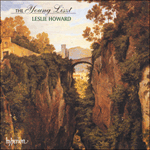Liszt’s Berceuse is the most interesting example of his relationship with Chopin’s style, embodying imitation almost to the point of plagiarism. Chopin’s own Berceuse—also in D flat major, also built on increasingly elaborate variations on a simple four-bar theme, also unfolding over a sustained tonic pedal-point—is clearly Liszt’s model. In fact, the situation is rather more complicated as Liszt’s piece exists in two very different versions, the first written in 1854, and the second in 1863. The first version (recorded here) is actually simpler in conception than Chopin’s Berceuse, largely free from florid embellishment and therefore lacking one of the defining features of Chopin’s work. The more familiar second version, while it retains the harmonic plan and the melodic basis of the original, is saturated with an almost overwhelming amount of filigree decoration, and is also much longer. In its simpler guise, Liszt’s Berceuse is a tranquil, contemplative work, akin to the Consolations in its quality of unspoilt innocence.
from notes by Tim Parry © 2000
La Berceuse de Liszt offre l’exemple le plus intéressant de sa relation avec le style de Chopin, personnifiant l’imitation pratiquement au point de plagiat. La propre Berceuse de Chopin, en ré bémol majeur, est également élaborée sur des variations de plus en plus intriquée d’un simple thème de quatre mesures qui se dévoile sur une pédale de tonique. D’emblée, on perçoit qu’il s’agit là du modèle de Liszt. En fait, la situation est nettement plus compliquée puisque la pièce de Liszt existe dans deux versions très différentes, la première écrite en 1854 et la seconde en 1863. La première version (celle qui a été retenue pour ce disque) épouse une conception plus simple que la Berceuse de Chopin, largement dénuée des ornements fleuris et omettant donc une des caractéristiques particulières de l’œuvre de Chopin. La seconde version—celle qui est la plus connue—est saturée d’une quantité pratiquement insoutenable de fioritures en filigrane tout en étant nettement plus longue. Parée de ses atours les plus simples, la Berceuse de Liszt est une œuvre pensive et tranquille, semblable aux Consolations dans sa qualité d’innocence naturelle.
extrait des notes rédigées par Tim Parry © 2000
Français: Isabelle Battioni
Liszts Berceuse ist das interessanteste Beispiel für seine Beziehung zu Chopins Stil, das die Imitation fast bis zum Plagiat treibt. Chopins eigene Berceuse—ebenfalls in Des-Dur, ebenfalls auf zunehmend aufwendige Variationen über ein schlichtes viertaktiges Thema aufgebaut, ebenfalls über einem ausgehaltenen Orgelpunkt in der Tonika entfaltet—ist eindeutig Liszts Vorbild. Tatsächlich ist die Situation ein wenig komplizierter, da Liszts Stück in zwei ganz unterschiedlichen Fassungen existiert, die erste von 1854 und die zweite von 1863. Die erste (hier eingespielte) Version ist vom Konzept her eigentlich schlichter als Chopins Berceuse, weitgehend frei von blumigen Ausschmückungen und deshalb ohne eines der charakteristischen Merkmale von Chopins Schaffen. Die bekanntere zweite Fassung bewahrt zwar die Harmonik und die melodische Basis des Originals, ist aber mit einer fast überwältigenden Menge filigraner Ausschmückung durchsetzt und auch viel länger. In ihrer schlichteren Gestalt ist Liszts Berceuse ein ruhiges, besinnliches Werk, den Consolations in ihrer Stimmung unverdorbener Unschuld ähnelnd.
aus dem Begleittext von Tim Parry © 2000
Deutsch: Anne Steeb/Bernd Müller


 Liszt: Complete Piano Music
Liszt: Complete Piano Music Liszt: The complete music for solo piano, Vol. 26 - The Young Liszt
Liszt: The complete music for solo piano, Vol. 26 - The Young Liszt
